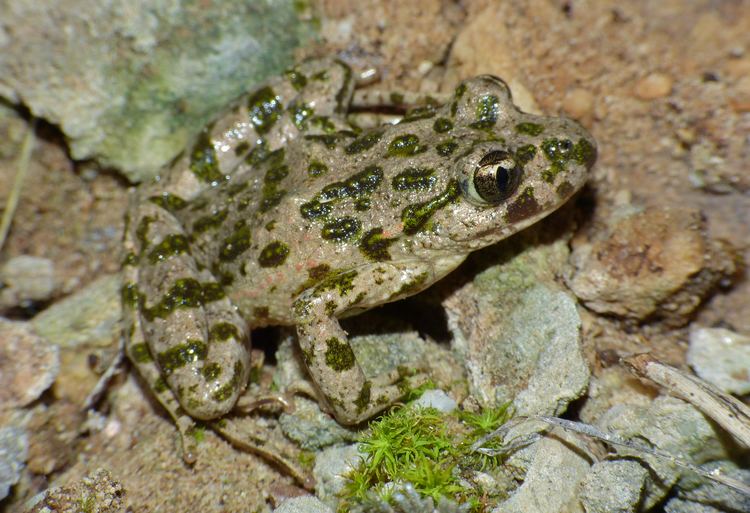Suborder Mesobatrachia Genus Pelodytes Phylum Chordata Rank Species | Order Anura Family Pelodytidae Scientific name Pelodytes punctatus | |
 | ||
Similar Parsley frog, Pelobates cultripes, Common midwife toad, Natterjack toad, Perez's frog | ||
Sapillo moteado com n pelodytes punctatus common parsley frog
The common parsley frog (Pelodytes punctatus) is a very small and slender frog with long hindlegs, flat head and vertical pupils. Males reach only 3.5, females 4.5 centimetres. The upper side of the body is variable in colour, usually with irregular green patches on a light brown, grey or light olive background. The frog's back is dotted with elongated warts, often in undulating longitudinal rows that can be orange along the flanks. Behind the protruding eyes and above the tympanum, there is short, small gland. It does not have parotid glands. The underside is white, and around the pelvis yellowy orange. In the mating season, males develop dark swellings on the insides of their digits and forelimbs, as well as on the chest. The males' forelimbs are stronger than females'.
Contents
- Sapillo moteado com n pelodytes punctatus common parsley frog
- Reproduction
- Distribution
- Ecology and behaviour
- References
Reproduction
In France, the breeding season lasts from the end of February to early April; in Portugal, it is from November to March. In Andalusia, this parsley frog may spawn several times a year. For laying places, it prefers weedy ponds and sometimes streams. The males create a relatively quiet croaking noise with the help of their paired inner vocal sacs, under water. The females may respond with a "kee, kee" vocalisation, similar to those of the little bustard and corn crake.
During mating, the male grabs the female around the waist with its front limbs, not under the arms, as the Neobatrachia do (also see amplexus). For laying the eggs, the amplexed couple will seek a vertical twig or reed in the water, on which the female attaches an egg mass only a few centimetres long, containing 40 to 300 eggs. These are dark grey to black on top and covered in jelly. The tadpoles need approximately three months until metamorphosis if no hibernation intervenes. Previous to this, they can reach a considerable 6.5 centimetres (9.5 cm) - longer than the adult animal!
Distribution
Common parsley frogs are found in open or semi-open, even arid landscapes, that are typically characterised by the occurrence of pine and holm oak stands. They seem to furthermore prefer calcareous soils. In the North of its distribution, this parsley frog hibernates from November to February/March, but does not hibernate in the South.
The distribution ranges from Spain up to the North of France, including France, Spain, Portugal and a small part of Northwestern Italy (Piemont and Liguria). In altitude, these frogs reach from sea level to middle mountainous regions. The distribution in France is the most continuous; here, only the Eastern edge and parts of the South West are not colonised. In the South of the Iberian peninsula, the Iberian parsley frog (P. ibericus Sánchez-Herraíz, Barbadillo-Escrivá, Machordom & Sanchíz, 2000) has come to be regarded as a separate species in recent years. The third Pelodytes species, the Caucasian parsley frog (P. caucasicus Boulenger, 1896), is spatially set apart with its distribution in the Caucasus and Turkey. This may be an example of allopatric speciation in ice age refugia.
Ecology and behaviour
During the day, the animals rest under stones or in burrows that they dig. They can also climb reasonably well. They hunt insects at night, and are predated by barn owls, amongst others.
